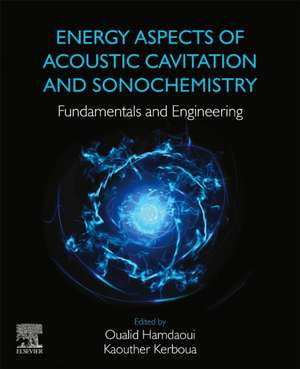Energy Aspects of Acoustic Cavitation and Sonochemistry: Fundamentals and Engineering
Editat de Oualid Hamdaoui, Kaouther Kerbouaen Limba Engleză Paperback – 19 aug 2022
Special interest is dedicated to the sonochemical production of hydrogen and its energetic dimensions. Due to the sensitive energy balance that governs this process, this is seen as a "green process" for the production of future energy carriers.
- Provides a concise and detailed description of energy conversion and exchange within the single acoustic cavitation bubble and bubble population, accompanying physical and chemical effects
- Features a comprehensive approach that is supported by experiments and the modeling of energy concentration within the sonochemical reactor, jointly with energy dissipation and damping phenomenon
- Gives a clear definition of energy efficiency metrics of industrial sono-processes and their application to the main emergent industrial fields harnessing acoustic cavitation and sonochemistry, notably for the production of hydrogen
Preț: 809.77 lei
Preț vechi: 1056.09 lei
-23% Nou
Puncte Express: 1215
Preț estimativ în valută:
154.95€ • 165.69$ • 129.19£
154.95€ • 165.69$ • 129.19£
Carte tipărită la comandă
Livrare economică 11-25 aprilie
Livrare express 13-19 martie pentru 102.86 lei
Preluare comenzi: 021 569.72.76
Specificații
ISBN-13: 9780323919371
ISBN-10: 0323919375
Pagini: 388
Ilustrații: Approx. 120 illustrations
Dimensiuni: 216 x 276 x 25 mm
Greutate: 0.9 kg
Editura: ELSEVIER SCIENCE
ISBN-10: 0323919375
Pagini: 388
Ilustrații: Approx. 120 illustrations
Dimensiuni: 216 x 276 x 25 mm
Greutate: 0.9 kg
Editura: ELSEVIER SCIENCE
Cuprins
Part I
The single acoustic cavitation
bubble as an energetic system:
qualitative and quantitative
assessments 1
1. Single acoustic cavitation bubble and
energy concentration concept 3
2. The energy forms and energy
conversion 23
3. Physical effects and associated
energy release 35
4. Sonochemical reactions, when, where
and how: Modelling approach 49
5. Sonochemical reactions, when, where
and how: Experimental approach 77
Part II
The bubble population:
an analytic view into mutual
forces and allied energy exchange 97
6. The Bjerknes forces and acoustic
radiation energy 99
7. Nonlinear oscillations and resonances
of the acoustic bubble and the
mechanisms of energy dissipation 109
8. Damping mechanisms of oscillating
gas/vapor bubbles in liquids 131
Part III
Ultrasound assisted processes,
sonochemical reactors and
energy efficiency 155
10. Efficiency assessment and mapping
of cavitational activities in
sonochemical reactors 157
11. Sources of dissipation: An outlook into
the effects of operational conditions 183
12. Mechanistic issues of energy
efficiency of an ultrasonic process:
Role of free and dissolved gas 193
13. Simulation of sonoreators accounting
for dissipated power 219
14. Technological designs and energy
efficiency: The optimal paths 249
Part IV
Green, sustainable and benign
by design process? The place
and perspective of ultrasound
assisted processes and
sonochemistry in industrial
applications based on energy
efficiency 263
15. Acoustic cavitation and sonochemistry
in industry: State of the art 265
16. Crystallization of pharmaceutical
compounds: Process Intensification
using ultrasonic irradiations -
Experimental approach 279
17. Sonochemical degradation of
fluoroquinolone and β-lactam
antibiotics – A view on
transformations, degradation
efficiency, and consumed energy 287
18. The use of ultrasonic treatment in
technological processes of complex
processing of industrial waste:
Energetic insights 299
19. The sonochemical and ultrasoundassisted
production of hydrogen:
energy efficiency for the generation
of an energy carrier 313
20. Future trends and promising
applications of industrial
sonochemical processes 329
21. Raising challenges of ultrasound-assisted
processes and sonochemistry
in industrial applications based on
energy efficiency 349
The single acoustic cavitation
bubble as an energetic system:
qualitative and quantitative
assessments 1
1. Single acoustic cavitation bubble and
energy concentration concept 3
2. The energy forms and energy
conversion 23
3. Physical effects and associated
energy release 35
4. Sonochemical reactions, when, where
and how: Modelling approach 49
5. Sonochemical reactions, when, where
and how: Experimental approach 77
Part II
The bubble population:
an analytic view into mutual
forces and allied energy exchange 97
6. The Bjerknes forces and acoustic
radiation energy 99
7. Nonlinear oscillations and resonances
of the acoustic bubble and the
mechanisms of energy dissipation 109
8. Damping mechanisms of oscillating
gas/vapor bubbles in liquids 131
Part III
Ultrasound assisted processes,
sonochemical reactors and
energy efficiency 155
10. Efficiency assessment and mapping
of cavitational activities in
sonochemical reactors 157
11. Sources of dissipation: An outlook into
the effects of operational conditions 183
12. Mechanistic issues of energy
efficiency of an ultrasonic process:
Role of free and dissolved gas 193
13. Simulation of sonoreators accounting
for dissipated power 219
14. Technological designs and energy
efficiency: The optimal paths 249
Part IV
Green, sustainable and benign
by design process? The place
and perspective of ultrasound
assisted processes and
sonochemistry in industrial
applications based on energy
efficiency 263
15. Acoustic cavitation and sonochemistry
in industry: State of the art 265
16. Crystallization of pharmaceutical
compounds: Process Intensification
using ultrasonic irradiations -
Experimental approach 279
17. Sonochemical degradation of
fluoroquinolone and β-lactam
antibiotics – A view on
transformations, degradation
efficiency, and consumed energy 287
18. The use of ultrasonic treatment in
technological processes of complex
processing of industrial waste:
Energetic insights 299
19. The sonochemical and ultrasoundassisted
production of hydrogen:
energy efficiency for the generation
of an energy carrier 313
20. Future trends and promising
applications of industrial
sonochemical processes 329
21. Raising challenges of ultrasound-assisted
processes and sonochemistry
in industrial applications based on
energy efficiency 349
